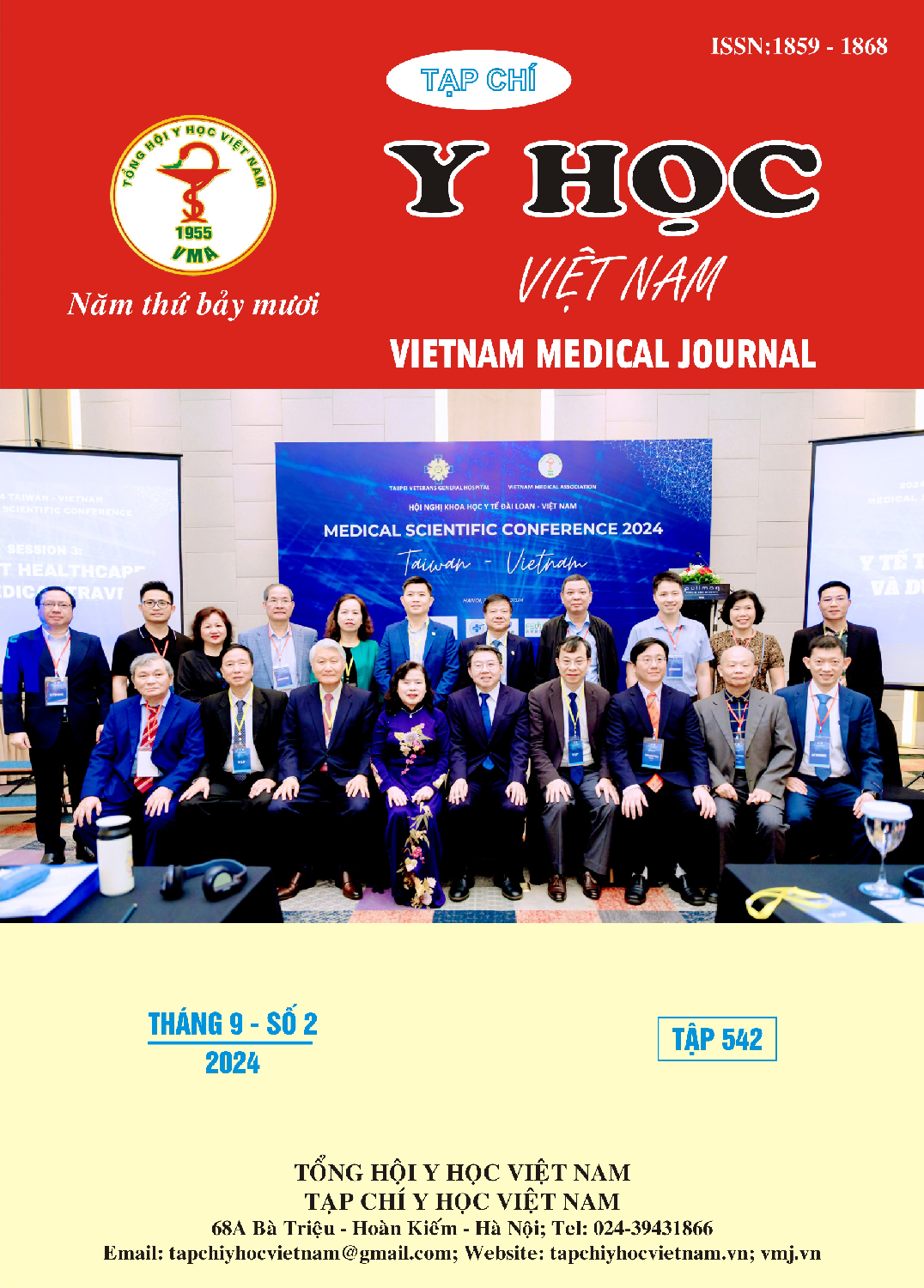RESULTS OF FENESTRATED PEDICLE SCREW FIXTATION WITH CEMENT AUGMENTATION FOR PATIENT WITH OSTEOPOROTIC THORACOLUMBAR FRACTURE AT VIET DUC HOSPITAL
Main Article Content
Abstract
Objectives: Evaluate the outcomes of fenestrated pedicle screw fixtation with cement augmentation for patient with osteoporotic thoracolumbar fracture. Objects and Methods: A longitudinal descriptive and prospective study on 45 patients with osteoporotic thoracolumbar fracture who underwent fenestrated pedicle screw fixtation with cement augmentation surgery Viet Duc Hospital from 06/2021 to 06/2023. Results: Among the 45 patients, male/female ratio = 1/1,5; with an average age of 66,4 ± 9,2. All patients had symptoms of thoracolumbar pain (100%), predominantly mild to moderate neurological damage, with a mean preoperative VAS score of 8.1 ± 1.0 and ODI index of 72.6 ± 5.9%. The average T-score for the sample patients were -3,6 ± 0,4. The average vertebral Cobb angle (V-Cobb) was 26,8° ± 4,1°, and the preoperative fixed segment Cobb angle (S-Cobb) was 26,5° ± 4,3°. The mean surgical time was 89.3 ± 11.9 minutes, with an average blood loss of 310.0 ± 68.9 ml and the average hospital stay of 7.2 ± 2.1 days. Intraoperatively, dural tears accounted for 4.4%, cement leakage around vertebrae 4.4%, and cement overflow into discs 8.8%. Postoperative complications included surgical site infection in 2.2% and urinary tract infection in 4.4% of patients. VAS and ODI scores at 1 and 6 months postoperatively significantly decreased with p<0.001. V-Cobb and S-Cobb postoperatively significantly decreased with p<0,05. Macnab quality of life scores at 6 months postoperatively showed good to excellent improvement in 95.6% of cases. Screw loosening rate was low at 1.4%, with no cases of screw breakage, pull-out screw, or rod fracture postoperatively. Conclusion: The result of fenestrated pedicle screw fixtation with cement augmentation surgery for patient with osteoporotic thoracolumbar fracture yields relatively good results, achieving significant clinical improvement and spine alignment correction. The incidence of intraoperative complications and postoperative complications is low.
Article Details
Keywords
fenestrated pedicle screw, osteoporotic thoracolumbar fracture cement augmentation.
References
2. Vaidya Govindarajan, et al. “Osteoporosis treatment in patients undergoing spinal fusion: a systematic review and meta-analysis”. Neurosurg Focus Volume 50. June 2021
3. Ville Puisto, Harri Risanen. Vertebral fracture and cause-specific mortality: a prospective population study of 3,210 men and 3,730 women with 30 years of follow up.; Eur Spine J. 2011 Dec; 20(12): 2181-2186
4. Pinar Kuru, et al (2014), “Fracture history in osteoporosis: Risk factor and its effect on quality of life” https://www.ncbi.nlm.nih.gov/ pmc/ articles/P MC4318399/
5. Wang H., Li C, Xiang Q. “Epidemiology of spinal fractures among the elderly in Chongquing, China”. 2012, J Care Injury
6. “Osteoporotic vertebral Fractures”. www.nhs.uk/ conditions/ Osteoporosis/ Pages/Introduction.aspx www.nos.org.uk/about-osteoporosis
7. Van Stata T.P, Leufkens H.G, Cooper C. “The epidemiology of corticosteroid-induced osteoporosis: a meta-analysis.” Osteoporos Int. 2002;13:777-787.
8. Jong Hun Seo, Chang Il Ju, Seok Won Kim, Jong Kyu Kim, Ho Shin. “Clinical efficacy of bone cement augmented screw fixation for the severe osteoporotic spine”. Korean Journal of Spine 2012;9(2):79-84
9. Guo-ye Mo, Teng-peng Zhou, et al. “Long-term efficacy and safety of bone cement-augmented pedicle screw fixation for stage III Kümmell disease”. Sci Rep. 2021; 11: 13647
10. Elke Rometsch, MSs, Maarten Spuit, MD, PhD, et al. “Screw-related complications after instrumentation of the osteoporotic spine: A systematic literature review with meta-analysis”. Global Spine J.2020 Feb; 10(1):69-88


